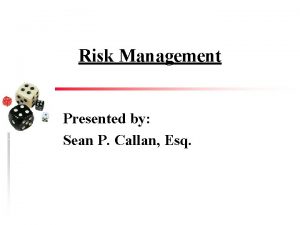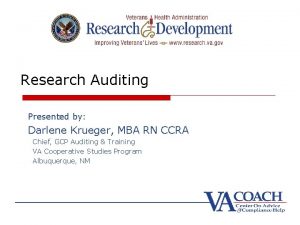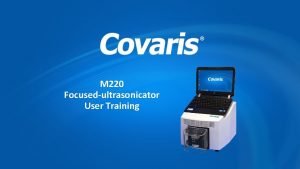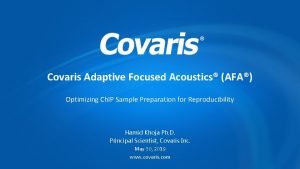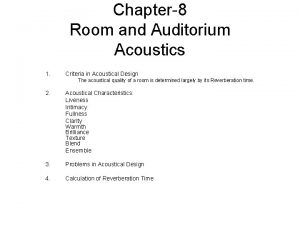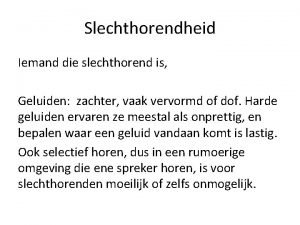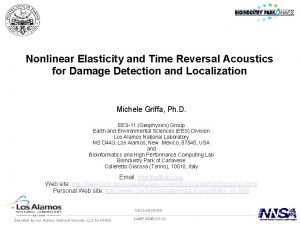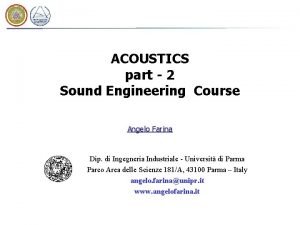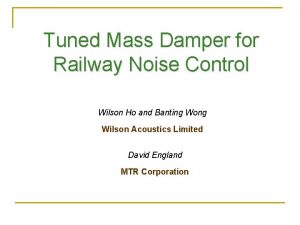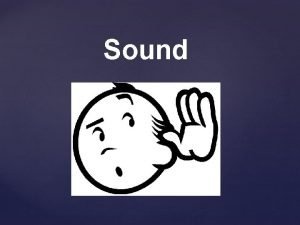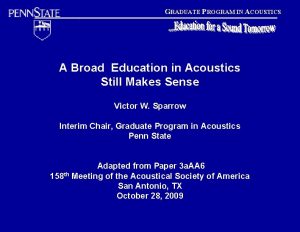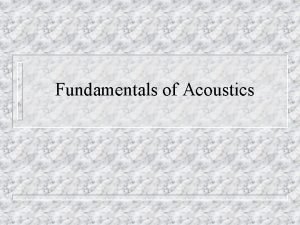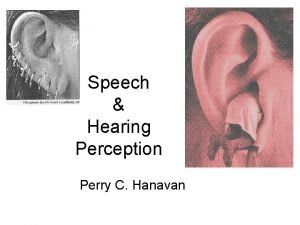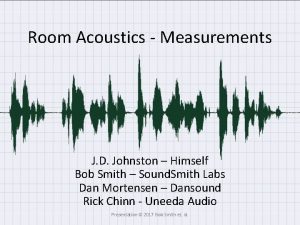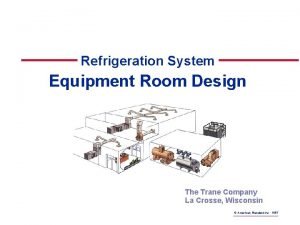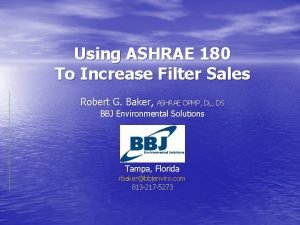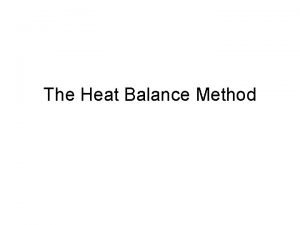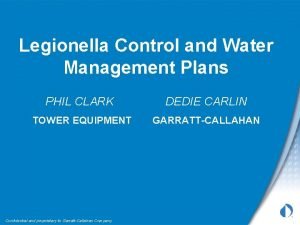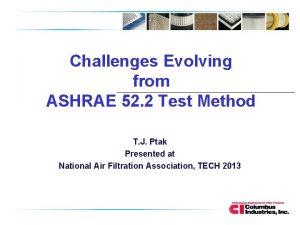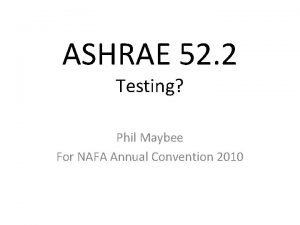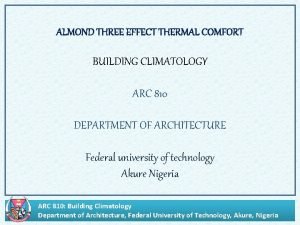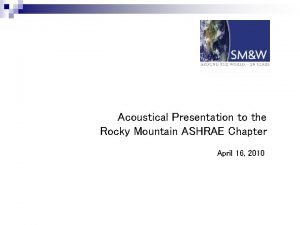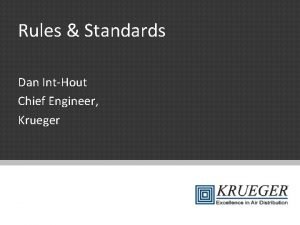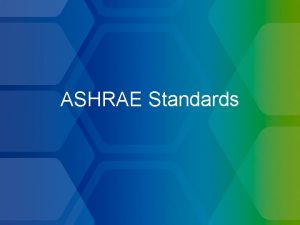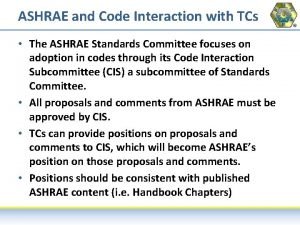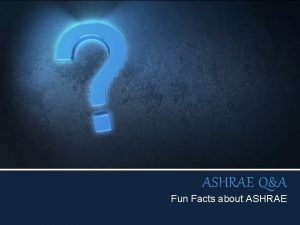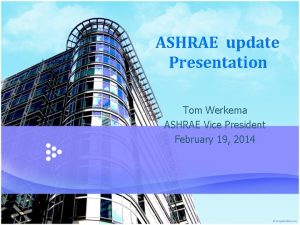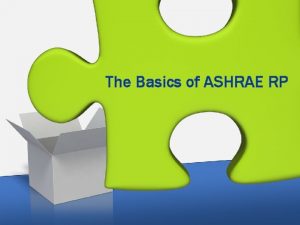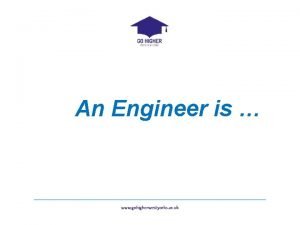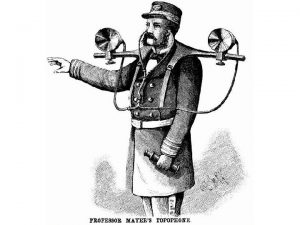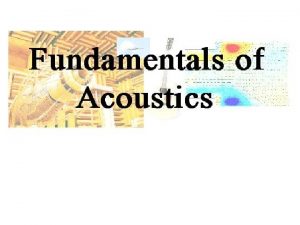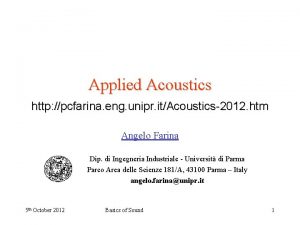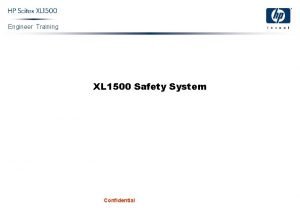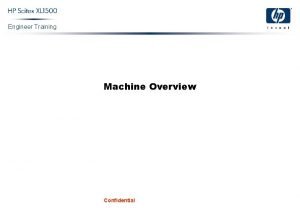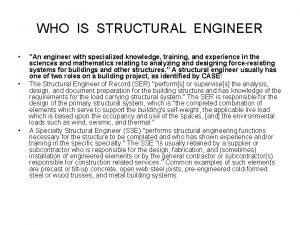Applied Acoustics Dan IntHout Chief Engineer Krueger ASHRAE



































- Slides: 35

Applied Acoustics Dan Int-Hout, Chief Engineer, Krueger ASHRAE Fellow & Life Member

Objectives Basic Acoustical Concepts Understanding Sound Power & Sound Pressure The Goals The Tools Setting Meaningful Specifications 2 | Applied Acoustics

Why do we care? Setting Meaningful Specifications Effective Problem Solving Getting the Best Overall Value! 3 | Applied Acoustics

Basic Concepts 4 | Applied Acoustics

Single Number Ratings NC, NR, & RC 5 | Applied Acoustics d. BA (A, B & C Scale) Sones & Bells STC & NRC

Evaluating Sound Data • Few products have octave band sound power data. • Octave band data is difficult to gather and use. • A single number value cannot be used in an acoustical acceptability analysis. 6 | Applied Acoustics

Sound Tests AHRI 880 AHRI 260 ASHRAE 70 Discharge Sound Radiated Equipment Return Inlet 7 | Applied Acoustics

ASHRAE Standard 70 • Method of test for diffusers, grilles and registers • Sound measurement requires the equivalent of 10 diameters of straight duct to eliminate and inlet effects! • Test method says to subtract 10 d. B for room effect, in all octave bands to estimate NC • When using ANY manufacturer’s data, one should probably add 5 d. B/NC for top inlet ceiling diffusers with flex connections and more typical room absorption. • Add 2 d. B/NC for side inlet plenums and ducted grilles. • Krueger is the only manufacturer to publish octave band sound data for All air outlets. • AHRI 885 spreadsheet has a way to include outlet generated sound. 8 | Applied Acoustics

End Reflection • Low frequency sound traveling down a duct will partially reflect back when encountering a rapid change in area. • The smaller the duct, the greater the effect. • There is an end reflection reduction in the reverb room in AHRI 260, but not in 880 until recently. • 880 has ignored reverb room end reflection for 40 years, but no longer! 9 | Applied Acoustics

End Reflection 10 | Applied Acoustics

End Reflection • The result of applying the end reflection correction to reverb room data is as much as a 10 d. B increase at 125 Hz. • Reported NC can go up as much as 10 NC. (the smaller the discharge duct, the greater the correction) • All manufacturers were required to include this correction in 2012. • Not everyone has! • Engineers should modify their sound requirements! 11 | Applied Acoustics

NC Curves 12 | Applied Acoustics

Typical NC Plot NC Rating is 45 since the highest tangent NC line is the one at 45. Approximate threshold of human hearing. 13 | Applied Acoustics

Diffuser NC Calculation 14 | Applied Acoustics

Diffuser & Box NC Calculation 15 | Applied Acoustics

NC & Speech Privacy 16 | Applied Acoustics

Making Accurate Predictions 17 | Applied Acoustics

Sound Paths D Sound Pressure Lp C O 2 3 4 1 5 6 18 | Applied Acoustics 1 = Casing Radiated & Inlet 2 = Duct Breakout 3 = Distribution Duct Breakout 4 = Flex Duct Breakout 5 = Discharge 6 = Outlet Generated Sound

AHRI 885 Application Standard 19 | Applied Acoustics AHRI Standard 885 formalized the process of estimating room sound pressure from known sound power. It includes ASHRAE tables for duct loss, breakout, and other factors. Designed for use with 880 data, it applies to 260 as well The most recent version is AHRI 885 -2013 (www. ahri. org).

AHRI 885 Contains flexible duct insertion loss and breakout tables. Defines the space effect. 20 | Applied Acoustics Contains a unique table for the ceiling plenum ‘transfer function’.

Space Effect • Diffuser NC typically assumes a 10 d. B room effect. • Actual room absorption is independent of room ‘harness’ and varies by band. • Absorption is dependent on room volume and distance from the sound source. 21 | Applied Acoustics

Space Effect 22 | Applied Acoustics

Radiated Sound 885 • Radiated sound is estimated by subtracting a combined ceiling/space effect (independent of room parameters) and the environmental effect from the unit’s radiated Sound Power. 23 | Applied Acoustics

Discharge Sound Factors • Factors that effect discharge sound transmission include End Reflection, Duct Insertion Loss, Flexible Duct Loss, and Elbows. • Power is reduced in all bands as the ducts branch out. • The Space Effect (and Environmental Effect) must be included. • End Reflection sound reduction should be included, even though sound power ratings were adjusted for it. 24 | Applied Acoustics

Discharge Sound Factors Mid Frequency, Hz 125 250 500 1000 2000 4000 Input Pwl 65 63 66 66 66 64 Lining Reduction 2 3 9 18 17 12 Elbow Reduction 0 0 0 Tee Reduction 0 0 0 Power Splits 5 5 5 End Reflection 9 4 1 0 0 0 Flex Duct Reduction 6 10 18 20 21 12 Environmental Adjustment Factor 2 1 0 0 Room Attenuation 5 6 7 8 9 10 Total Attenuation 28 30 40 51 51 38 Output Spl 37 33 26 15 15 26 Output NC 28 Output RC 19 Other (Custom) 25 | Applied Acoustics

Discharge Sound Factors Manufacturers are now required to use Appendix E to compute NC in catalogs. In the past, it was difficult to compare different manufacturer’s units. In 1999, AHRI 885, Appendix E was established with standard deducts as a function of flow rate. 26 | Applied Acoustics

Discharge Sound, Appendix E 27 | Applied Acoustics

Radiated Sound, Appendix E In appendix E, only one ceiling type is used. 28 | Applied Acoustics

Good Sound Specs Should… • • • Be based on clearly stated assumptions. Reflect real project needs. Specify octave band sound power. Specify max allowed sound power. Require “end reflection adjusted” data And Should Not… • Over silence. • Hinder IAQ performance. 29 | Applied Acoustics

Calculation Spreadsheet 30 | Applied Acoustics

Wrapping Up 31 | Applied Acoustics

Summary Acoustical response is greatly effected by installation. It’s easier to design right, than to correct! After construction, all problems are difficult. 32 | Applied Acoustics Effects can be predicted. Avoid problems through careful design and installation.

Summary • NC levels are well suited for product ratings. • RC levels are a better indication of quality. • Over-silencing may cause poor indoor air quality. • Tools are available to assist in the analysis. • Download AHRI 885 from www. ahri. org. 33 | Applied Acoustics

ANY QUESTIONS? 34 | Applied Acoustics

Contact Information Dan Int-Hout dint-hout@krueger-hvac. com Read my Blog on the Krueger website! www. krueger-hvac. com 35 | Applied Acoustics
 Chief engineer of the union pacific railroad
Chief engineer of the union pacific railroad Chief engineer standing orders examples
Chief engineer standing orders examples Chapter 9 lesson 3 commander in chief and chief diplomat
Chapter 9 lesson 3 commander in chief and chief diplomat Krueger vav boxes
Krueger vav boxes Scott krueger
Scott krueger Anita krueger md
Anita krueger md Norris krueger
Norris krueger Darlene krueger
Darlene krueger Mayan acoustics
Mayan acoustics Adaptive focused acoustics
Adaptive focused acoustics Adaptive focused acoustics
Adaptive focused acoustics Room acoustics design criteria
Room acoustics design criteria Lawaaidoofheid gehoorapparaat
Lawaaidoofheid gehoorapparaat Perceptieslechthorendheid
Perceptieslechthorendheid Acoustics
Acoustics Lecture hall acoustic design
Lecture hall acoustic design Angelo farina
Angelo farina Wilson acoustics limited
Wilson acoustics limited Acoustics
Acoustics Acoustics graduate programs
Acoustics graduate programs Fundamentals of acoustics
Fundamentals of acoustics Ear
Ear Jd acoustics
Jd acoustics Peters uncertainty in acoustics (epub|pdf|mobi)
Peters uncertainty in acoustics (epub|pdf|mobi) Andrzej kin
Andrzej kin Ashrae standard 15 refrigerant monitor
Ashrae standard 15 refrigerant monitor Ashrae standard 202
Ashrae standard 202 Ashrae standard 180
Ashrae standard 180 Transfer function method cooling load
Transfer function method cooling load Ashrae 188 water management plan
Ashrae 188 water management plan Ashrae52.2
Ashrae52.2 Ashrae tac
Ashrae tac Ashrae certification
Ashrae certification Ashrae 52
Ashrae 52 Ashrae comfort chart
Ashrae comfort chart Rocky mountain ashrae
Rocky mountain ashrae




